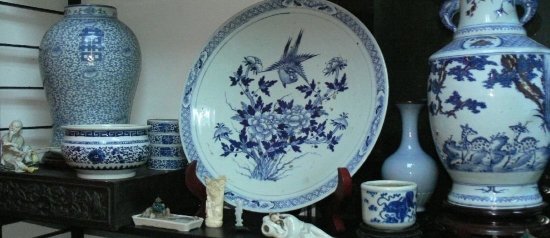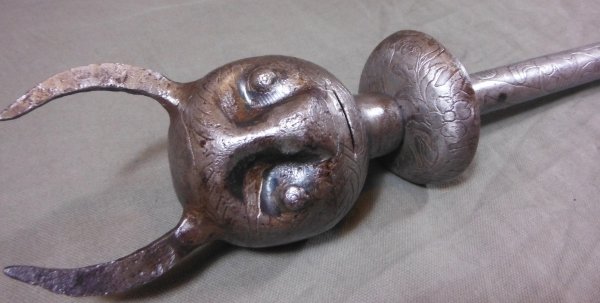Once a month the city of Arezzo, in the heart of Tuscany, hosts the Fiera Antiquaria the largest open-air antiques fair in Italy. Throughout the year, on the first Sunday and the Saturday preceding it, 1000 dealers, large and small, set up stalls in the city’s central square and along all the cobblestone streets leading from the medieval heart of Arezzo towards its more modern neighborhoods. To the delight of 25,000 buyers and browsers, the booths display a wealth of goods ranging from authenticated antiques through interesting collectibles to tourist souvenirs. It’s east/ to spend every bit of two days perusing what’s on display.
The well-respected antiques dealers of Arezzo are there with displays of old prints, Italian country furniture, and glass. Dealers from other Italian towns and cities – Siena, Florence, and Cortona – are also there. Many specialize, displaying only linens and white goods, for example, or china. This past June, one table was covered with Royal Copenhagen collectors plates ranging in price from £10 to £20 each. Another dealer, offering French and English bone china, displayed a square Limoges cup and saucer for £25, a Limoges tea set for £100.
Several stalls were littered with bits of metal, hinges, light fixtures, and door pieces, the remains of ancient houses now for sale to the renovators of other ancient houses. Massive andirons and huge hooks for fireplace cooking looked out of scale for homes in the United States but would work in the centuries-old farmhouses of Tuscany.
The most apparent bargains were pieces of furniture. Dining tables, armoires, magnificent chests, and couches set out along streets and around squares looked weighty and imposing. The pieces of Italian country-style furniture are made of various dark stained woods, some inlaid with patterns in a lighter oak. They ranged in price from a few hundred to a few thousand, dollars and seemed the most bargainable of the items “n display, at least to the Italians who were doing most of the buying.
There were unexpected offerings, too. At small tables mixed with the dealers stalls and the displays of imposing furniture were individuals with something to sell. Immigrants from former Soviet republics offered family silver, USSR military memorabilia, and Russian language books. Two Africans displayed carved wood bowls and statues on a brightly colored blanket. Another stall displayed artifacts the dealer asserted to be legally obtained Etruscan pieces. And one old man sat on a cobblestone street next to a gate leg table on which he displayed small colored glass bottles and old coins, dug up, he said, from his farm.
For those looking for a small memento, the stalls selling prints and paper ephemera were a good place to shop. In several booths, illustrations from old books, black and white drawings of Italian towns, botanical prints and hand-colored illustrations of animals were mixed in with plates depicting 18th and 19th century European military uniforms, magazine ads from the beginning of the 20th century, and 1920s Italian services. The prices were reasonable – Italian ad cards for fifty cents, services for a dollar, 75-year-old magazine ads as inexpensive as $5 – and the pieces were easy to pack. Books can also be tempting. In June, one of the offerings was a 1737 English New Testament with over 40 illustrations and a family provenance that made it seem worth the £500 the dealer was asking.
Arezzo is only an hour south of Florence by car and on the main railroad line between Rome and Florence. The stalls of the Fiera Antiquaria are within a 10minute walking distance of the train station. For vacationers to Tuscany whose stay coincides with the first Sunday of the month, a side trip to the Arezzo Antiques Fair is worth considering.
Here are a few tips to make the visit more pleasurable:
1. There’s a lot of territory to cover. Everything from properly authenticated antiques to brand new tourist souvenirs is on display. If time is limited, go to the Piazza Grande first and work back towards the edges. The sheer number of stalls can be distracting. Having something specific in mind helps limit the time it takes to get through the streets of stalls.
2. Although not essential, knowing a little Italian helps. There’s a pleasant festival air about the antiques fair and vendors go the extra mile to help. Many dealers can get along in noun-and-verb English (or German or French) but it helps to know a bit of Italian: please (per favore), thank you (grazie), how much (quanta costa), that’s too much (e troppo), I’ll take it (lo prendo). Spoken Italian numbers and prices can be hard to understand, so carry paper and a pen to write numbers down when asking prices or bargaining and ask the dealer to do the same (Duo scriverlo? is Italian for “could you write it down?”). If all else fails, the dealers are glad to help with phrase book Italian, or tourist pantomime.
3. Don’t expect too many bargains. With the exception of furniture, which seems quite reasonably priced, little of what’s on sale is a great bargain. The dealers know what they have, know their market values, and know their customers. Which is not to say that bargains can’t be found. They can. But it will take some digging.
4. Do expect some surprises. The men on the blanket selling African goods and the guy displaying rococo gilt framed mirrors sharing a CD player belting out American rock music. The smell of jasmine, which seems to come from down the street but is actually from the pots on the window sill overhead. The large photograph of Benito Mussolini, which dominates a stall displaying WWII memorabilia from Italy. Vendors eating their lunches and taking their mid-day rests in their stalls, all the while selling to passersby.
It’s all part of the Fiera Antiquaria d’Arezzo. And it’s wonderful.




